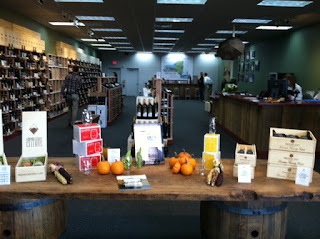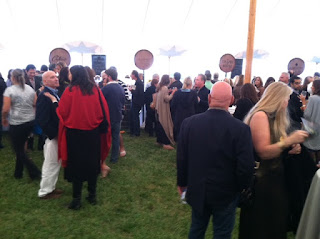Chardonnay has certainly shouldered its fair share of abuse over the last few years. Perhaps the disproportionate share of poor quality wine to good bears much of the responsibility for this peculiar trend. And there is no doubt an overabundance of yellow plonk out there masquerading as the genuine article. I can still recall the perennial joke whereby the bar patron asks for "ABC" wine, the "ABC" being an acronym for "Anything But Chardonnay."
That was back when a preponderance of Pinot Grigio was probably being poured, along with Soave and Sauvignon Blanc and scores of nondescript German Rieslings and French vin de pays. All of which is fine. But for serious summer quaffing, in my view, the wine most worth considering is Chardonnay. More than any other white varietal, Chardonnay makes it into Wine Spectator Magazine’s Top 100 Wines of the Year consistently year after year, many of them from California.
Chardonnay is, of course, the name of the grape varietal that is rooted in the traditions of France's southeastern Burgundy wine producing region. But it took winemakers in California to promote the varietal to the rest of the world. Today, when someone requests a glass of Chardonnay, it is almost always assumed that they mean California Chardonnay.
And why not? To begin with, French Burgundies comprised mostly of Chardonnay are prohibitively expensive these days and often are so overwhelmingly oakey that, to the untrained palette, they can taste almost sherrified. Further, stories abound of blind tastings where California Chardonnays far surpass white Burgundies, in many cases the American wine costing a fraction of the French one.
This seems to be happening with increasing frequency--it first occurred in the early 1970's-- with every successive growing season. And while Australia and New Zealand have demonstrated an admirable ability to produce decent Chardonnay, most are either overly oaked or too lacking in distinctive fruit flavor for the American palate.
To be sure, the California approach to winemaking differs vastly from that of Europe or Australia, so much so that many Chardonnays these days are said to be in the "California style" even if they are made in other states such as Oregon, Washington, Virginia, Texas and New York. The best California Chards are crisp, clean and well balanced in acidity, tannins and fruit. And, depending on where it's from, range from light bodied, delicate, and crisp, to full bodied, rich, and oakey. Cooler growing areas--known as appellations--such as those in Oregon, Washington, New York, and California's Central Coast, generally make for Chardonnays that have higher acidity, medium body and lighter fruit flavors.
The other, warmer parts of California, particularly the glamorous, celebrated appellations of Napa and Sonoma, produce wines with richer, more complex flavors and fuller body. And while California continually turns out some of the best Chardonnays I've ever tasted, the wines of Oregon and Washington are improving tremendously, with many already achieving a level of quality almost equal to topnotch producers in Napa, Sonoma and Monterey.
Not far behind Napa and Sonoma is New York's burgeoning wine producing region, the north fork of Long Island, where there are more than 50 wineries now flourishing, all producing entirely palatable Chardonnay, including special reserve bottlings. Many of these producers have achieved such high quality Chardonnay, one might even classify them as equal to California's best.
There is no doubt that Chardonnay is best enjoyed in the warmer months, from May through October. Nothing is more soothing than a hearty merlot or spicy Zinfandel to accompany a Thanksgiving Day repast, and for sitting by the fire afterward, a glass of vintage Port is unequaled. But when the spring begins to bloom and out come the tulips and barbecue grills, I love to christen the new season with a crisp, citrus edged yet buttery Chardonnay. Indeed, whenever I grill out on my deck, a glass of wine is as important as a pair of tongs and a homemade marinade. And that wine is almost always Chardonnay, either from California or one of the wineries not more than a half hour drive from my house on the north shore of Long Island. In fact, I often bask in the idea that the wine in my glass came from Chardonnay grapes grown just 25 miles away.
While Napa Valley continues to be home to the most prestigious Chardonnay producers, including Beringer, Robert Mondavi, Chalk Hill, Cakebread, Forman, Far Niente and Pahlmeyer, to name just a few, Sonoma, in recent years, has made strides as well, turning out collectible Chards that match Napa for quality and finesse. Producers such as Kistler, Sonoma-Cutrer, Simi, Ferrari-Carrano, Toad Hollow and a number of wineries in the Carneros region have fast become major entities in cellars nationwide.
Even newer is the Central Coast Monterey region, where arguably the best Chardonnay producer in all of California thrives--Robert Talbott. Although this winery is small compared to big league producers such as Kendall Jackson, (who bought major acreage adjacent to Talbott a decade ago) Glen Ellen and Beringer, owner and winemaker Robb Talbott turns out a number of bottlings, including the Sleepy Hollow Estate, Diamond T and the less expensive Logan. Noted Wine critic Robert Parker has been quoted as saying: "There are those who believe Talbott turns out the best Chardonnay in California and I would not argue with them." Talbott gets my vote for the most complex Chardonnays I've ever had the pleasure to imbibe, both from the winery's French oak barrels and from a glass.
While Talbott was one of the first to plant Chardonnay rootstocks in the hilly terrain of this mountainous region, Napa and Sonoma winemakers have been falling all over themselves to secure acreage in this heretofore untapped viniferous Eden. Apart from Robert Talbott, other well established quality Chardonnay producers in Monterey include Bernardus, Chalone and Morgan.
The best Monterey Chardonnays may not match Napa in terms of sheer power, but with regard to ripeness, complexity and finesse, many of the wines from this region are becoming the new standard bearer. Add excellent acidity and the ability to balance that acidity with a broad palette of tropical fruit flavors and you've defined the Coastal California Chardonnay style at its best. In many ways, the cooler climate of the region provides the winemakers of the area with the edge they need to produce Chardonnays with an impressive degree of finesse, in some cases even more so than their better known neighbors to the north.
Part of the attraction of Chardonnay is discovering the style of wine one prefers, whether it originate from the various appellations of California, Oregon and Washington out west, Texas and Virginia in the south, or New York and Connecticut in the northeast. All have their particular style, along with individual winemakers who invariably put their own spin on the finished wine. Experiment. Try as many as your wallet will allow, from the cheapest bottle, to more expensive and rarer bottlings. Tasting Chardonnay is the best possible way to learn the pleasures and rewards of this great varietal. It won't be long before you'll be asking the bartender or waiter for "NBC" wine...Nothing But Chardonnay.
My Top Ten Chardonnays
While I am continually trying new Chardonnays, this list represents my favorites, the wines I come back to time and again. I've chosen these wines based on consistency, quality and flavor, along with value, though some are a bit expensive. I have not included vintages because even in difficult years these producers still made wines that were better than most. Enjoy!
Ferrari-Carano Reserve, Napa Valley, CA
Moderate body. Finely balanced. A touch of oak, with clean, smoky aromas and hint of green apple. Beautifully textured and complex, with yeasty, spicy flavors reminiscent of vintage Champagne. Long, echoing finish. Don't miss it.
Robert Mondavi Reserve, Napa Valley, CA
Excellent balance of fruit and acid. Hefty body. Toasty notes layered with spice and hints of vanilla. New oak accents underneath. Buttery texture with generous apple and pear flavors that finish with a clean, citrus edge. Amazing consistency.
Robert Talbott Sleepy Hollow, Monterey, CA
Medium-bodied. Moderately acidic. Hints of new French oak layered with toast and minerals. Amazingly complex, with delicate, buttery mouthfeel giving way to tropical fruit flavors accented with vanilla. Wonderful aromas and long, lasting finish. Best of Class.
Beringer Private Reserve, Napa Valley, CA
Full-bodied. Well balanced between acid and fruit. Toasty flavors up front, with clean, new oak accents underneath. Rich and powerful, with subtle spice flavors revealed in the long, intense finish. Truly elegant. California Chardonnay at its best.
Chalone Vineyards Reserve, Chalone, CA
Moderate-body. Beautifully balanced acidity, with a tight core of citrus fruits. Silky in texture and intriguingly aromatic. Hints of floral perfume the nose. Rich mouthfeel with a long, lemon tinged finish. Worth searching for.
Mark West, Russian River Valley, CA
Full-bodied. Demonstrably acidic but delicately balanced. Very forward tropical fruit flavors framed in a buttery textured mouthfeel. Hints of exotic spice and vanilla run through the long, vibrant finish. A great find at a great price.
Cambria Katherine's Vineyard, Santa Maria Valley, CA
Medium body. Creamy texture with echoes of new French oak that give way to ripe fruit flavors tinged with citrus. Beautifully balanced between the fruit flavors, yeasty undertones and acid. Complex yet accessible. Lovely finish. Beautifully made.
Villa Mt. Eden Grand Reserve, Bien Nacido Vineyard, Santa Maria Valley, CA
Medium body. Buttery, textural mouthfeel, with mango, papaya, even banana flavors underneath. Increasingly less acidic in recent vintages but ripe and flavorful, with a fine balance of oak and smoke. Rich finish keeps you coming back for more.
Pellegrini, North Fork, Long Island
Medium-body. Nicely balanced and impeccably made. Creamy in texture, with crisp fruit flavors up front echoing a subtle taste of new oak. Moderate acidity yet intensely flavorful. Crisp and clean. Nice finish. One of Long Island's new classics.
Wolffer Estate Reserve, South Fork, Long Island
Made of 100% Dijon-clone Chardonnay planted in 1993, this barrel-fermented wine offers up vanilla and dried-pineapple aromas, and a bit of lime zest. The palate opens into pear and cream flavors, with a long, minerally finish.




























